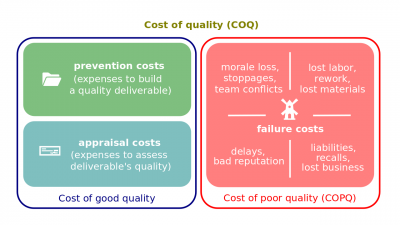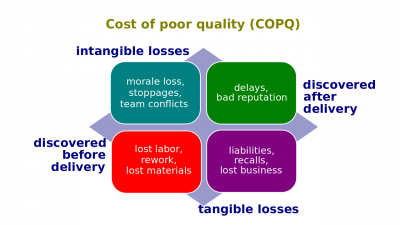Cost of quality
Cost of quality (also known by its acronym, COQ; hereinafter, the Cost) is two parts of all the costs incurred to ensure quality. These two parts are:
- Cost of good quality (also known as costs of conformance), which are money spent to avoid failures or, in other words, to keep the work products defect-free. They include prevention and appraisal costs.
- Cost of poor quality (also known by its acronym, COPQ, as well as failure cost, costs of non-conformance, or costs of failure of conformance), which are money spent because of failures or, in other words, of failure of keeping the work products defect-free. They include tangible and intangible internal (i.e. before the marketable reaches the customer) and external (i.e. after the marketable reaches the customer) costs.
The PAF paradigm is another name that represents the concept of the Cost; PAF is the acronym for prevention, appraisal, failure.
Contents
Trivia
Definitions
According to Managing Quality by Foster (6th edition),
- PAF paradigm. Refers to prevention, appraisal, and failure costs of quality.
Total cost
- Main wikipage: Three spheres of quality
- The Cost is a part of the total cost of quality (also known as costs of quality and quality costs). The total cost includes both the Cost and those expenses on quality management that the Cost excludes. The three spheres of quality depict this circumstance.
Cost of good quality
Cost of good quality or costs of conformance are money spent to avoid failures or, in other words, to keep the produced marketables defect-free. These costs include prevention and appraisal costs.
Appraisal costs
- Main wikipage: Appraisal cost
- Appraisal costs (also known as quality control costs) are related to auditing, evaluating, measuring, and testing the work products. These costs include destructive testing loss, inspection, and testing expenses.
Prevention costs
- Main wikipage: Prevention cost
Optimal Cost
Cost of poor quality
- Main wikipage: Cost of poor quality
- Cost of poor quality (also known by its acronym, COPQ, as well as failure cost, costs of non-conformance, or costs of failure of conformance) is money spent because of failures or, in other words, of failure of keeping produced marketables defect-free. According to Juran's Quality Handbook by Defeo (7th edition),
These costs include tangible and intangible internal (i.e. before the marketable reaches the customer) and external (i.e. after the marketable reaches the customer) expenses.Cost of poor quality (COPQ). The costs that would disappear in the organization if all failures were removed from a product, service, or process; typically measures of a percent of sales or total costs.
Lindvall-Juran Curve
- If the cost of good quality and cost of poor quality are equal, the Cost is economically the lowest and the conformance level is considered optimal. The Lindvall-Juran Curve represents that phenomenon.



